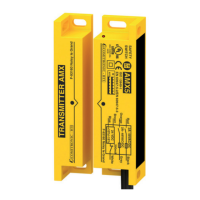Miscellaneous information
Safety sensors and RFID technology
1. RFID technology
1.1. Why ?
The RFID in the safety sensors is of interest if you need to have a dierent code for each guard, on each
machine, and, in particular, for the sensors placed on the outside of the machines, or thus accessible.
According to ISO 14119, RFID coding must be classied as "high". Pay close attention because some
RFID security sensors have a "low" coding level, when they are provided with a unique code*; this
makes no dierence in our "ACOTOM process3". The standard does not impose a particular solution;
it depends on the needs of the application, or remains at the customer's discretion.
*Note: this unique coding requires code management and generates an additional workload for the
maintenance and purchasing departments.
1.2 Disadvantages
• RFID is a radio frequency technology and therefore the security component cannot be concealed
behind a metal wall or embedded in the equipment. They are exposed to the environment, which
limits their scope. For example, they cannot be used in the agri-food industry.
• Safety sensors with RFID are often associated with OSSD safety contacts. This principle causes a
delay in the safety (OFF position) which is most important. The impact on the design of the machine
is real, and it is necessary to make or redo an evaluation of the safety distance to check whether the
position of the access with respect to the dangerous movement should be modied.
• There are three types of components
- Those with a unique code: no interest
- Those whose code is xed by construction
- In the event one of the parts breaks, it is necessary to replace both parts
- Those whose code is re-writable thanks to a special RFID key
- In the event one of the parts breaks, we can replace that part only
1.3 Our RFID "AXKEF Process" Solution
• XORF-SA10 or SA12: a detection distance of 12 mm (nger protection)
• XORF-SA25: a detection distance of 25 mm
• Delivery of an RFID key for erasing the code, as well as tamper-proof screws (from May 2018) and
washers
• Automatic code programming (up to 16 million) through self-learning (AXKEF process): once instal-
led, just close the door and the code is transferred. Then, the recording is locked.
• Dierent code each time or unique code upon request
• XORF-SA2: autonomous component SIL 2/PL d, with OSSD 500 mA safety contact
AXKEF
The solution for having a dierent code for each guard and on each machine
6
WITHOUT CODE MANAGEMENT
BY PURCHASING OR MAINTENANCE

